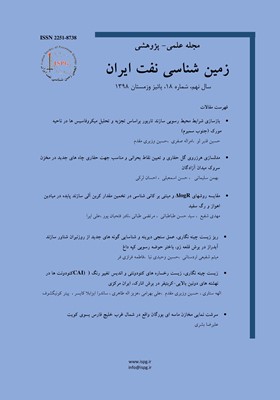مدلسازی هرزروی گل حفاری و تعیین نقاط بحرانی و مناسب جهت حفاری چاه¬های جدید در مخزن سروک میدان آزادگان
محورهای موضوعی : زمین شناسی نفتبهمن سلیمانی 1 , عباس اسماعیلی 2 , احسان لرکی 3
1 - دانشگاه شهیدچمران
2 - دانشگاه آزاد اسلامی واحد امیدیه
3 - دانشگاه ازاد واحد تهران
کلید واژه: میدان نفتی آزادگان, سازند سروک, ریسک حفاری, الگوی هرزروی, نرم افزار GS+ ,
چکیده مقاله :
هرزروﯼ ﮔﻞ ﯾﮑﯽ از ﻣﺸﮑﻼﺗﯽ متداول در ﺣﻴﻦ ﺣﻔﺎرﯼ ﺳﺎزﻧﺪ ﻣﯽ ﺑﺎﺷﺪ. هدف از انجام این مطالعه ارزیابی پدیده هرزروی سازند سروک (با سن سنومانین) در میدان آزادگان بعنوان مهمترین سازند مخزنی غنی از هیدروکربور و تهیه مدل آن در محیط نرم افزار GS+ است. این سازند متشکل از توالی ضخیمی از سنگ آهک و میان لایه هایی از سنگ آهک رسی بوده و بر اساس مشخصه های پتروفیزیکی به 7 زون تقسیم شده است. برای این منظور ویژگی هایی از قبیل وزن گل حفاری، فشار پمپ، هرزروی و عمق هرزروی 9 حلقه چاه مورد بررسی قرار گرفت. نتایج حاصله نشان می دهد با وجود ثابت بودن وزن گل و فشار پمپ ها، وجود شکستگی های فراوان در سنگ مخزن تاثیر گذار بوده و بیشتیرین میزان هرزروی در زون 3 و کمترین میزان هرزروی در زون 7 رخ می دهد. براساس نتایج حاصل از الگوهای داده های هرزروی بنظر می رسد گسلها، مورفولوژی محیط رسوبی (نظیر کانالهای رسوبی) نقش عمده ای در ایجاد شکستگی و یا مناطق مستعد هرزروی داشته باشند. تفاوت در الگوهای مشاهده شده هرزروی بیشتر تائید کننده جابجائی وضعیت کانالی در طول زمان در بخشهای مختلف مخزن است. به طور کلی بیشترین میزان هرزروی در یالهای شمالی و جنوبی، و در قسمت میانی میدان، هرزروی پایین است. حفاری به روش زیر تعادلی در نقاط خاص این میدان برای کاهش آسیب های ناشی از هرزروی بالای گل حفاری پیشنهاد می گردد.
Drilling mud loss is considered as one of common problems encountered during excavation. The aim of this study is to evaluate of mud loss of the Sarvak Formation (Cenomanian age) in Azadegan oil field which is known as the most important rich hydrocarbon reservoir in the Zagros region by providing the model in the environment of GS+ software. This formation consists of a thick sequence of limestone and clay limestone layers, which is divided into 7 zones based on petrophysical characteristics. For this purpose, available data such as drilling mud weight, pump pressure, mud loss, and related depths of 9 drilled wells were investigated. The results showed that despite of the operating factors including the weight of drilling mud and the pressure of the pumps were kept constant, the presence of fractures in the reservoir rocks causes to occur mud loss significantly in zone 3 while it is observed the lowest level of mud loss in zone7. Based on the results of mud lost data patterns, faults, sedimentary environments morphology (such as sedimentary channels) seem to play major roles in creating fractures or areas susceptible to mud loss. The difference in observed patterns of mud loss is more likely to confirm the relocation of channel status over the time in different parts of the reservoir. In general, the highest rate of mud loss was detected in the northern and southern edges while the lowest rate was happened in the middle part of the field. It is suggested to prevent mud loss hazards in this field, underbalanced drilling method should be used.
